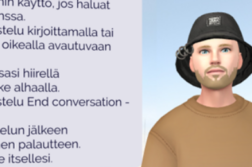The beginning of the year for digital pedagogy mentors has been spent conducting quality audits of Learn workspaces. In total, 59 randomly selected modules have been audited. In March, the LeaDPlus team gathered at the Hämeenlinna University Centre to analyze the results of the audits. Katja Holopainen, the new digital pedagogy mentor from the School of Health and Social Services, joined the team and immediately participated in reviewing the results, guided by her colleagues. The meeting focused on identifying school-specific strengths, good practices, and development areas. In the April meeting, the review of the results continued with a clarification of theme-specific quality criteria and development measures from the perspective of the entire university.
The module’s entirety develops through collaborative design
The first part of the audit related to the overall module structure, which had five criteria. It was noted that in practice, modules are very diverse. Some modules are designed and implemented as one clear entity, while at the other extreme, they are constructed from several different courses that operate completely independently. From the auditor’s perspective, the criteria related to the module’s entirety were only partially met for some modules.
As with other themes, strengths and areas for development vary by school. A strength noted was that the courses’ learning objectives and assessment criteria are presented, and the learning process and the student’s progression are clearly displayed. Particularly in one school, the modules form a clear whole, while in others, this is one of the areas for development. A common area for development for all is making the students’ overall workload and time use estimates visible.
Accessibility facilitates everyone’s learning
Accessibility means that the content and materials of workspaces are available, understandable, and usable for everyone. In this theme, there were ten criteria, of which the following were identified as strengths: materials do not require special programs or logins to open, links are descriptively named and functional, activities are descriptively named and used appropriately, and schedules are visible.
The biggest area for development is the accessibility of audiovisual material, such that videos include subtitles, audio files have text equivalents, long videos are divided into sections, and the duration of videos are indicated.
The clarity of learning tasks is significant for the student
The third totality of the audit relates to learning tasks, which had seven criteria. A strength was identified in the implementation of tasks appropriately, mainly as an activity on the learning platform. In addition, the information sources and working instructions for the tasks were presented quite clearly. One school’s strength was a uniform task structure, made possible by using a template for task instructions available in the workspace. This way, all the criteria related to the learning task are easily met. There was a lot of variability in the task instructions, especially lacking were the purpose/goal of the task, evaluation criteria, and the student’s time management.
Guidance, feedback, and evaluation enhance interaction and sense of community
In the fourth auditable entity, the possibilities for the interaction between teacher and students and tracking progress were examined using four criteria. Strengths identified included the availability of a question-and-answer channel for students, although this was not implemented in all courses. Additionally, the responsible teachers and schedules for guidance were mostly visible. The use of a completion progress bar in implementations was noted as a strength in one school. Conversely, this is an area for development in other schools. A common area for development identified for all was the use of the gradebook tool in Learn.
The next step is the utilization and sharing of results
Key to clarifying the workspaces of modules and study courses, as well as the learning process of students, is the joint planning by teachers, agreeing on common practices, and the practical implementation of the university’s digital pedagogy guidelines. Digital pedagogy mentors will share the strengths of implementations and good practices within their schools and guide teachers towards even higher quality executions. The LeaD team’s experts modify guidelines and conduct coaching sessions and information snippets.
The audit has also been a collective journey and communal experience for the mentors. Enthusiastic and active work in workshops and cheerful discussions often continued long after the end of a joint meeting. As a result of the process, the ”Hamk Learn Clear” criteria were jointly modified, which at least those of us who participated in the audit have a common understanding. Digital pedagogy mentors felt that their own expertise grew significantly through the auditing of workspaces. As Mikko Kekki, the digital pedagogy mentor from the School of Business, Design, and Technology, puts it: ”This audit process has been a journey that has offered me new insights and strengthened my professional growth.”
Read more
”Making HAMK Learn clear” Criteria (internal)
Leena Mäkinen, 24/7 Learning Designer, LeaD team. On the plus side (in Finnish Plussan puolella) is a series of blog articles covering topics related to digital pedagogy and the work of HAMK’s LeaD Team and digital pedagogy mentors. Original photo: Adobe Stock



